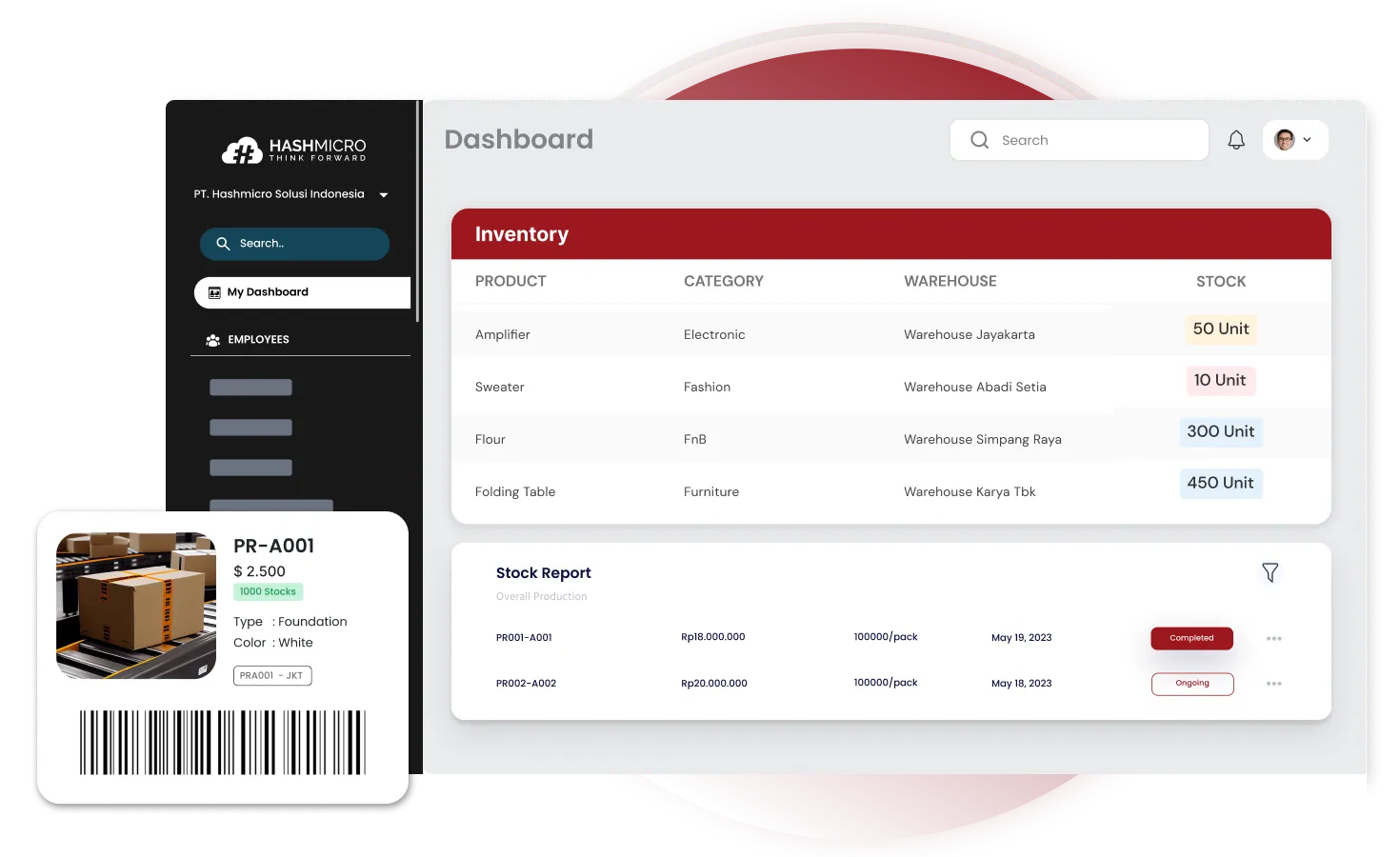Imagine running a business where you always know exactly how much stock you have at any given moment. No surprises, no shortages, and no need for a last-minute rush to restock. Sounds perfect, right? But how is this possible? Many businesses still rely on outdated systems that lead to costly errors and inefficiencies.
This is where a perpetual inventory system comes in. It promises to keep your inventory updated in real-time, ensuring smooth operations. But what exactly is a perpetual inventory system, and how does it work? Let’s explore.
Key Takeaways |
Table of Contents

What Is a Perpetual Inventory System?
A perpetual inventory system is a method that keeps track of inventory levels continuously. Unlike traditional methods, where you update stock counts periodically, this system updates inventory every time there is a sale, return, or restock. It provides businesses with real-time data on their stock levels, helping them make informed decisions instantly.
Imagine you run an online electronics store. Each time a customer buys or returns a smartphone, your perpetual inventory system instantly updates stock levels. Similarly, when new headphones arrive, the system updates the count in real-time. This ensures you avoid stockouts of popular items and overstocking of slow-moving ones, optimizing inventory and reducing costs.
In this way, a perpetual inventory system gives you greater control over your inventory, reduces errors, and allows you to respond more quickly to changes in customer demand with the help of an inventory report.
Key Features of Perpetual Inventory System
The perpetual inventory system stands out for its ability to provide accurate, real-time insights into stock levels, making it a valuable tool for businesses. Here are three key features:
- Real-time Updates: The system continuously updates inventory levels with every sale, return, or restock. This helps businesses monitor stock instantly, prevent stockouts or overstocking, and respond quickly to changes in demand.
- Automation:The system automatically records transactions and updates stock without manual intervention. This reduces errors, saves time, and allows employees to focus on more critical tasks, improving overall efficiency.
- Integration with Other Business Systems:The system integrates with sales, finance, and procurement, ensuring that every transaction is reflected across all systems. This creates seamless coordination between departments and enhances decision-making.
Want to see how inventory software can enhance your inventory management? HashMicro’s inventory software includes all the features above and other ones that will boost your business inventory management. Contact us for a free demo and experience firsthand how our software can transform your inventory management.
Perpetual vs. Periodic Inventory Systems
The main difference between periodic and perpetual inventory systems lies in how frequently stock levels are updated. In a periodic system, inventory is only updated at set intervals, such as monthly or yearly. In contrast, a perpetual system updates instantly with every transaction, providing businesses with real-time information.
The perpetual inventory system offers several key advantages. It provides up-to-date stock levels, reduces the need for manual work, helps prevent stock shortages or overstocking, and improves decision-making through accurate data.
However, despite these benefits, there are some disadvantages. Implementing a perpetual system can be costly, and it requires proper technology and software to function smoothly.
So, why should businesses choose a perpetual inventory system over a periodic one? The benefits, including real-time data and automation, make it a more efficient and accurate choice for managing inventory.
Read More: Top Manufacturing Inventory Software
Benefits of Using a Perpetual Inventory System
Implementing a perpetual inventory system offers several key advantages that streamline operations and improve efficiency. Let’s explore the specific benefits that make this system so valuable.
- Real-time Inventory Tracking: Real-time tracking ensures businesses always know their stock levels, helping to prevent stockouts. This allows for timely reorders and better customer satisfaction.
- Reduced Manual Work: Automated updates reduce the need for manual stock counts, saving time and effort. Employees can focus on more important tasks, improving efficiency and lowering labor costs.
- Better Accuracy in Inventory Levels: By recording each transaction instantly, the system minimizes errors in stock counts. This results in more accurate data, enabling businesses to make informed purchasing decisions and reduce waste.
- Cost Savings in Inventory Management: The inventory control system prevents overstocking, reducing storage costs and freeing up capital. It also helps prevent stockouts, which ensures that there’s no missed sales.
With these clear benefits, it’s time to look at how businesses can actually use a perpetual inventory system in their daily operations.
How to Use a Perpetual Inventory System
Using a perpetual inventory system involves several key steps that streamline inventory management. Each step contributes to more accurate, automated, and efficient stock control. Let’s walk through the process.
Step 1: Recording Sales and Purchases
The first step in using a perpetual inventory system involves automatically recording transactions. When a sale occurs or inventory is purchased, the system immediately adjusts stock levels. For instance, if a business sells 10 units of a product, the system reduces the inventory count by 10, ensuring that inventory levels remain current.
Step 2: Updating Inventory Levels Automatically
One of the greatest advantages of a perpetual system is its ability to automatically update inventory in real-time. As transactions occur, the system adjusts stock levels without manual input. This automation gives businesses accurate and current information on available stock, reducing the risk of discrepancies.
Step 3: Tracking Cost of Goods Sold (COGS)
The system also tracks the cost of goods sold (COGS). Each time an item is sold, the system automatically updates the COGS, ensuring that financial records accurately reflect the cost of inventory sold during a specific period. This is essential for calculating profitability and maintaining precise financial statements.
Step 4: Automating Purchase Orders
When stock levels fall below a preset threshold, the perpetual inventory system can automatically generate purchase orders to replenish inventory. This automation saves time, ensures stock availability, and prevents the risk of running out of popular items. Businesses can set up specific order management points to trigger these orders, making the process more efficient.
Once you have these steps in place, using specific formulas can further optimize your inventory management.
Common Formulas in Perpetual Inventory
Several key formulas help businesses optimize stock management within a perpetual inventory system.
Economic Order Quantity (EOQ)
The EOQ formula helps businesses calculate the optimal order quantity that minimizes the total costs of inventory, including holding and ordering costs. It ensures that you order just the right amount, avoiding excess stock or frequent reordering.
Where:
D = Demand (units per year)
S = Ordering cost per order
H = Holding cost per unit per year
Cost of Goods Sold (COGS)
COGS is calculated by adding the beginning inventory to purchases made during the period, then subtracting the ending inventory:
Ending Inventory
Formula Ending inventory is calculated by subtracting the cost of goods sold (COGS) from the total goods available for sale:
With these formulas, businesses can further refine their perpetual inventory processes, but they also need to apply the right valuation methods.
Examples of Inventory Valuation Methods in Perpetual Systems
Choosing the right valuation method is essential for accurate inventory accounting. Here are three common methods used in a perpetual system.
FIFO (First-In, First-Out) Method
The FIFO method assumes that the first items added to inventory are the first ones sold. This method is common in industries dealing with perishable goods or items with expiration dates, ensuring older stock is sold before newer stock.
LIFO (Last-In, First-Out) Method
The LIFO method assumes that the last items added to inventory are sold first. While less commonly used, this method can be useful in industries where prices are rising, helping businesses reduce taxable income by reporting higher COGS.
Weighted Average Cost Method
This method calculates the average cost of all items in stock, dividing the total cost of goods available for sale by the total number of units. It smooths out price fluctuations and provides a fair valuation of inventory and COGS.
Managing inventory with these methods and formulas helps businesses stay efficient and cost-effective. If all of this seems complex, a robust inventory management system solution can simplify the process.
Read more: Top Construction Inventory Management Software
How HashMicro’s Software Can Take the Hassle Out of Inventory Management
Managing inventory manually often leads to common issues like stock discrepancies, errors in data entry, and an inability to respond quickly to changes in supply and demand. This is where HashMicro’s Inventory Software steps in, making your perpetual inventory system more efficient and hassle-free:
- Automated Inventory Tracking: No more manual stock counts. HashMicro’s software tracks inventory in real-time, automatically updating stock levels with every sale, purchase, or return. This ensures you always have accurate data and reduces the risk of stockouts or overstocking.
- Real-Time Data Integration: Forget outdated spreadsheets. Our software provides instant updates on inventory, sales, and stock movements, allowing you to make quick, informed decisions and seamlessly adjust your inventory strategy to align with Just-in-Time practices.
- Multi-Location Management: Whether you manage inventory in one warehouse or across multiple locations, the recommended inventory solution by HashMicro system provides a unified view of your stock, making it easy to optimize inventory levels at each site.
- Smart Reordering System: Automate reorder points to ensure you always have the right amount of stock, eliminating the guesswork. This helps prevent both shortages and excess inventory, streamlining your operations.
- Custom Reports and Analytics: Get detailed insights into your inventory performance with custom reports. Use these insights to fine-tune your inventory management strategies and boost efficiency.
Ready to eliminate the manual work and take your perpetual inventory system to the next level? Try HashMicro’s Inventory Software with a free demo and see how it can help you save time, reduce costs, and manage your inventory like a pro!
Conclusion
In today’s fast-moving business world, sticking to outdated inventory methods is like trying to use a flip phone in the age of smartphones—it just doesn’t cut it. A perpetual inventory system is your secret weapon for staying ahead, offering real-time updates and seamless automation that keep your stock in check and your business on point.
Why settle for good enough when you can have the best? With HashMicro’s Inventory Software, you’ll not only manage your inventory like a pro, but you’ll also free up time and energy to focus on growing your business. Ready to level up your inventory game? Book your free demo now and see the magic in action!

Frequently Asked Questions
-
Is perpetual inventory lifo or fifo?
Perpetual inventory is flexible—it can use LIFO or FIFO, depending on how you want to track stock flow. Think of it as customizing how your inventory gets accounted for, in real-time or at intervals.
-
What is perpetual and continuous inventory system?
Perpetual and continuous inventory systems are like having a smart assistant for your stock—every sale, return, or restock gets logged instantly, so you’re always in the loop with up-to-date inventory levels.
-
What is the difference between FIFO perpetual and FIFO?
FIFO perpetual updates your stock in real-time with every transaction, while regular FIFO is more relaxed, only updating during specific intervals, such as at the end of a reporting period.


























